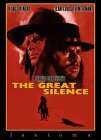
Today we are going to finish this two-chapter series about Spaghetti Western. We will review the “punch” of this genre by means of some titles that shape it.
Let´s begin with my favourite film in the genre: Leone’s “Once Upon a Time in the West” (obvious choice). Leone had already shot the “Dollars trilogy” (the previous three films), although this is the movie in which he reaches the greatest refinement and technical perfection. Without leaving the peculiar characteristics of these kind of films, Leone obtains his most personal movie, tinged with a slower narrative tempo than previous ones.
Once upon a time in the “Spaghetti West (II)”: three different sights.
The famous “Trilogy” provided Leone with fame and a good amount of money, so he could count on two actors with whom he had wanted to work previously but wasn´t allowed to because of budget reasons: Charles Bronson and Henry Fonda. Bronson’s work as the man with the harmonica is simple, limited but very effective for Leone’s purposes. But Henry Fonda, the merciless Frank (less hallucinated than Gian Maria Volonté in “A Fistful of Dollars” or “For a Few Dollars More
”), makes a 180 degree turnover in his career as an actor. He stamps in the character a sinister force very few times reached.
There are many more factors to emphasize in the film: the immaculate staging, the extraordinary performance of a brave Claudia Cardinale (Jill), the epic sense of filming, the capacity of visual persuasion, the emphatic mythical soundtrack composed by Morricone and, over all, unforgettable scenes. For example:
a) Frank’s first appearance.
b) Jill’s arrival to McBain’s farm.
c) The final duel, of course, in which the hidden reason for Harmonica’s vengeance is revealed.
d) And I will specifically mention Claudia Cardinale’s eyes. Pay attention to Jill’s look when Harmonica comes back after the duel. I think this is one of the best non-speaking scenes in the history of Cinema.
Many other directors followed Leone. Among the most gifted, we can find the Sergios (Sollima and Corbucci). The last one shot “Il grande silenzio” (The great silence), a strange Spaghetti Western to consider.
In this movie, all the constants are kept: the villain is a ruthless killer, his name is Loco (which means “mad”) and is portrayed by the singular Klaus Kinski (I think he was “slightly mad” in real life. Ask Werner Herzog, for example, if you don´t believe me). But the hero isn´t a man of few words; he is simply dumb. “Quelle domage!”
The hero is hired by a lonely woman to face the villain. Until here, everything is normal. Moreover, there is Morricone music. Ok. It´s all right, except for … Well. There is a snowy landscape, instead the typical dusty one (a very original idea for a western). But “Il grande silenzio” will surprise you with its original ending. I don’t want to tell more than the necessary, but I think this is the least common ending I remember in a Western. It will stun some of you, and it will amuse some other people.
Finally, following the distortions in the genre, we can find some sub-products like the quirky “Django Kill” (aka “If you live, shoot!).
Giulio Questi is responsible for this … movie? Maybe. Let me explain by commenting on the first scene: two hands appear from an open tomb. They are the Stranger’s hands. But, who is the Stranger? In one cutoff scene bullets seem to pass through his body. I can´t tell you more of this extremely violent film, but you shouldn’t lose how he dies: I can only say that there are some vampire bats in the scene.
I must advise you that it is not a film for all kinds of people, but –as an anthropological research on human behaviour- it´s “enjoyable”.
We have gone over three very different movies of the genre. Now you can choose, and don´t forget to have fun!
Related Article: Once upon a time in the “Spaghetti” West.